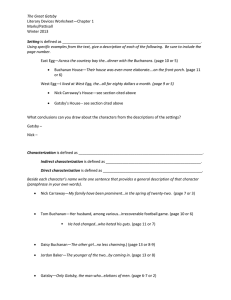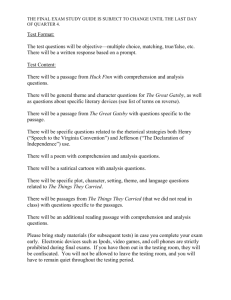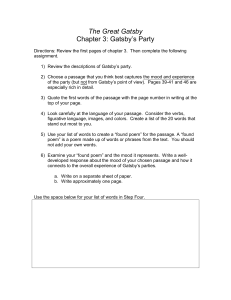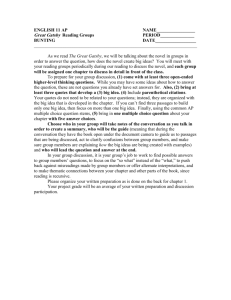The Great Gatsby Final Essay
advertisement
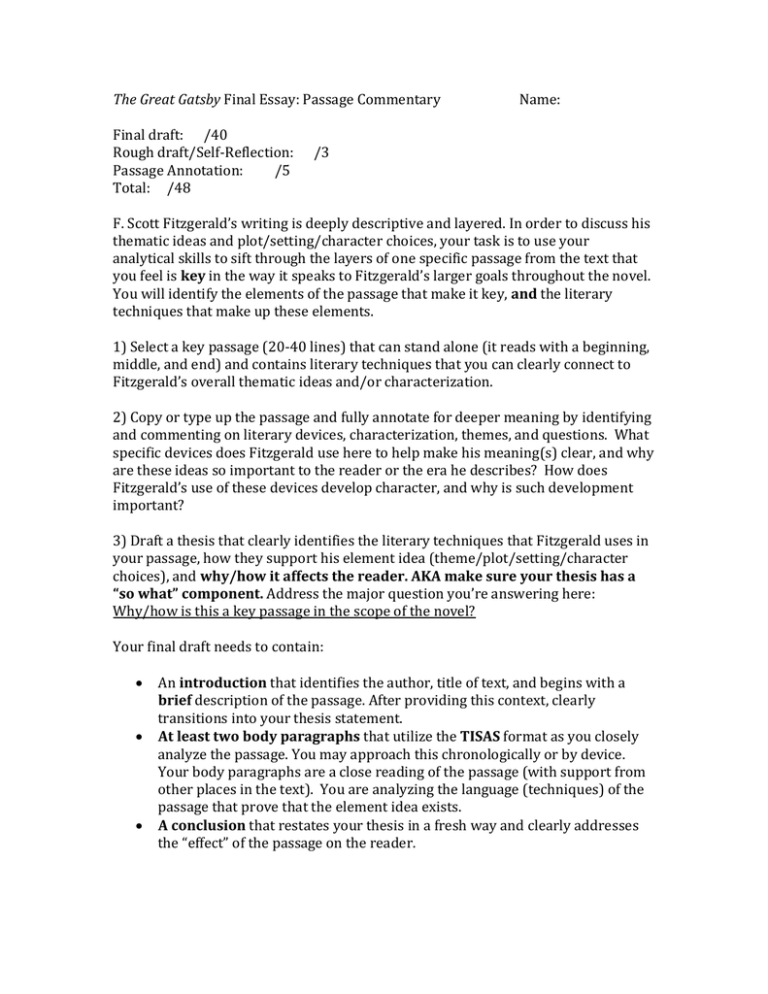
The Great Gatsby Final Essay: Passage Commentary Final draft: /40 Rough draft/Self-Reflection: Passage Annotation: /5 Total: /48 Name: /3 F. Scott Fitzgerald’s writing is deeply descriptive and layered. In order to discuss his thematic ideas and plot/setting/character choices, your task is to use your analytical skills to sift through the layers of one specific passage from the text that you feel is key in the way it speaks to Fitzgerald’s larger goals throughout the novel. You will identify the elements of the passage that make it key, and the literary techniques that make up these elements. 1) Select a key passage (20-40 lines) that can stand alone (it reads with a beginning, middle, and end) and contains literary techniques that you can clearly connect to Fitzgerald’s overall thematic ideas and/or characterization. 2) Copy or type up the passage and fully annotate for deeper meaning by identifying and commenting on literary devices, characterization, themes, and questions. What specific devices does Fitzgerald use here to help make his meaning(s) clear, and why are these ideas so important to the reader or the era he describes? How does Fitzgerald’s use of these devices develop character, and why is such development important? 3) Draft a thesis that clearly identifies the literary techniques that Fitzgerald uses in your passage, how they support his element idea (theme/plot/setting/character choices), and why/how it affects the reader. AKA make sure your thesis has a “so what” component. Address the major question you’re answering here: Why/how is this a key passage in the scope of the novel? Your final draft needs to contain: An introduction that identifies the author, title of text, and begins with a brief description of the passage. After providing this context, clearly transitions into your thesis statement. At least two body paragraphs that utilize the TISAS format as you closely analyze the passage. You may approach this chronologically or by device. Your body paragraphs are a close reading of the passage (with support from other places in the text). You are analyzing the language (techniques) of the passage that prove that the element idea exists. A conclusion that restates your thesis in a fresh way and clearly addresses the “effect” of the passage on the reader. Format that follows the essay format we’ve used this year: MLA heading on top left-hand side, your last name and page number on top right-hand side, a centered, creative title, 12 point font, Times New Roman. Key Elements/Thematic Ideas: Description of Gatsby—what do they conjure and to what end? Ideas about society—1920s, class differences, gender roles Character descriptions—are these “real” characters, what is the function of each character? Character relationships—what do these relationships “mean”, represent, or reveal about the time period, class differences, human nature, gender roles, etc. Life in East Egg v. West Egg—why the contrast? Why East vs. West? Observations of rich people and poor people and old money vs. new money Creation of Gatsby’s image vs. his internal and external realities Nick’s feelings (or lack thereof)—why is he narrator, how does he change, why does he change, what are his moral realizations Tom’s actions—what do they show about him, about old money, about gender roles Wilson’s and Tom’s reactions to wives cheating—what do each reveal? Gatsby’s hidden life—why does it have to be hidden? How does he create it, and why is he compelled to do so? Actions of Daisy and Gatsby—what do their different actions reveal about them? Reality of the past vs. reality of the future Naïveté—how/why is Nick naïve? Why does Daisy fake her naïveté? Statements of loneliness—what function do these statements serve thematically? Daisy’s true nature vs. her persona—what does this difference reveal? Old/new Gatsby—what does this shift/change reveal about him and humankind? Gatsby’s mental state—how does it change, and why does it change? Aspects of society and the individual—what’s the role of the individual in this society? How people view Gatsby—and why is this important? Publicity around Gatsby, especially at his death—what does it suggest? Setting—importance of New York, Ash Heaps, the Midwest? Literary Techniques: Mood created by author’s tone Tone of narration—when does Fitzgerald use 1st person, 3rd person, use of flashback Diction (word choice) Words of nature, chance, fate/free will, distance, dreams and hopes Symbol/Motif Colors Descriptions and metaphors attached to architecture Suspense/tension (techniques used to create it) Foreshadowing Simile, metaphor, personification Passages without Nick Irony

